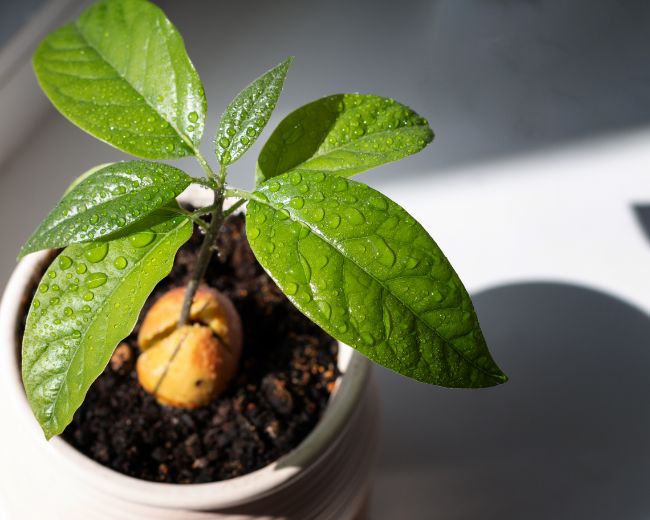We love avocados for their light buttery flavor, nutritional content, and pretty green flesh. They are considered a superfood for a number of reasons. But did you know you can grow an avocado tree from seed?
How to grow avocado tree from seed: You can suspend your avocado seed over water with toothpicks, soak them in water until they start to sprout, start them off in a baggie, or even plant them directly into damp soil. It will take 3-6 weeks before roots develop, about 3 months for them to get to 6 inches tall and at least 5 years to bear fruit.
Avocado trees make beautiful houseplants with vibrant green foliage. With the right conditions and a little patience, they may even bear you some pretty flowers and delicious fruit to enjoy. Keep reading for a step by step guide on how to grow an avocado tree from seed. You’ll also learn how to care for your avocado tree, how long it takes to grow real avocados, and how to troubleshoot any challenges your sprouts may have.

Four Ways To Grow An Avocado Tree From Seed
There are four ways to grow an avocado tree from seed.
- The Toothpick Method
- The Baggie Method
- The Soaking Method
- The Soil Method
Avocados are native to Mexico and also grow well in California and Florida. Most avocado varieties need to have mild temperatures and good humidity to grow outdoors. But since they don’t like cold temperatures, it is unlikely that avocados would grow outdoors in Grow Zones 7 and below.
If you live in a colder growing zone, you can still grow your own avocados from seed, just grow them inside as a beautiful houseplant. You can use any of the following four methods to sprout your avocado pits.
The Toothpick Method For Growing An Avocado Tree From Seed
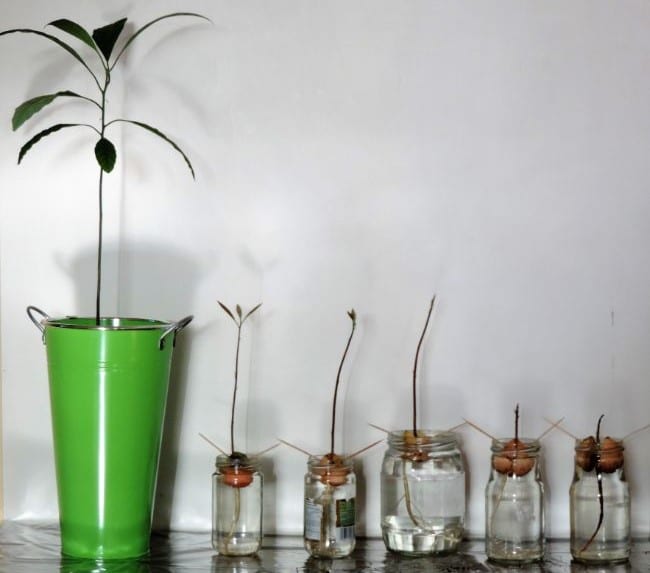
This is perhaps the most well-known method of sprouting avocado seeds. You’ve probably seen it in any number of Facebook Hack videos and other online tutorials. It’s pretty simple, and it is fun to watch the seeds sprout and grow this way. You’ll need an avocado pit or seed, a few toothpicks, and a glass or jar to get started.
- Carefully open your avocado. Generally, you can use a sharp knife to slice all the way around a ripe avocado. Be careful not to cut yourself or the seed hiding inside.
- Pull out the seed and rinse it gently in warm water.
- Set the seed flatside down on your work space.
- Insert three toothpicks about half way up the avocado, equally around the seed.
- Suspend the seed by the toothpicks over a cup or small bowl of water, so that the bottom of the seed (the flat part) is wet.
- Set the cup and seed in a sunny window and wait for it to sprout. After the roots are established, you can plant your sprouted avocado seed in soil.
The Baggie Method For Growing An Avocado Tree From Seed
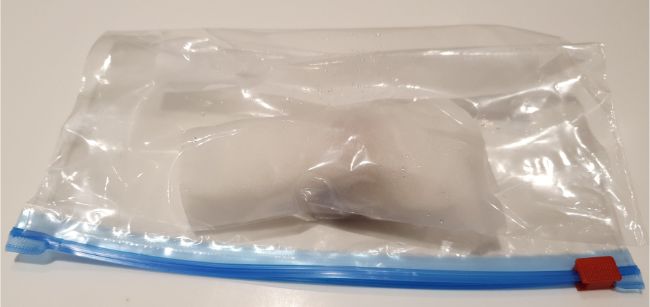
The baggie method is a great way to start seeds of all kinds, including avocado seeds. This is an easy method of seed starting and you can easily check on your seeds for progress without disturbing them too much. You’ll need a baggie, an avocado pit, a paper towel, and water.
- Open your avocado, as explained above.
- Pull out the seed and rinse it gently in warm water.
- Wrap the seed in a damp (not soaking wet) paper towel or other cloth.
- Slide the seed and towel into a baggie but don’t close it.
- Put the baggie in a warm dark place and check on it every few days.
- Your avocado should sprout in a few weeks.
- Once your avocado has a root that is three inches long, you are ready to plant it.
The Soaking Method For Growing An Avocado Tree From Seed
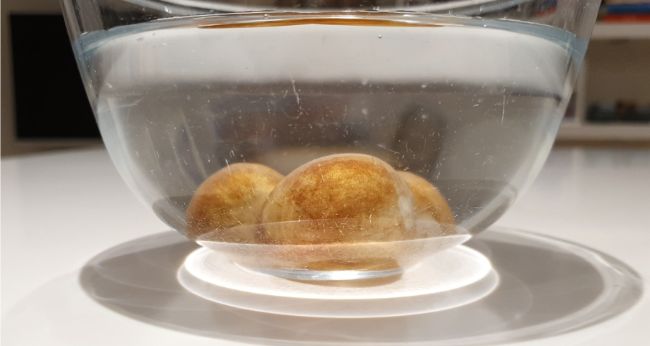
The soaking method works well when you are starting multiple avocado seeds at the same time. You’ll need your avocado pits and a large bowl, jar, or container to soak them in.
- Open your avocados and gently remove the pits.
- Put all of your avocado seeds in a clear vase or other container and fill it with water.
- Set the vase in a sunny spot.
- Rinse the seeds and put in fresh water every few days.
- Watch closely for growth. Once the seeds have sprouted, remove them from the water and plant them in soil.
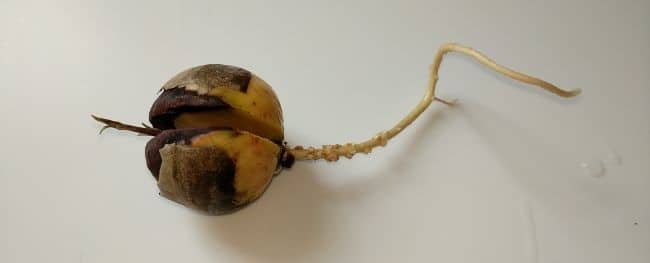
After you have sprouted your avocado seeds using any of the methods above, you’ll need to move it to soil. You’ll need a container with good drainage holes and well-draining potting mix.
Fill the container about 2/3 full with potting mix. Make a hole for the roots, which should be about three inches long. Place the seed in the hole and fill it with dirt. Leave the top part of the seed sticking out of the dirt.
The seed or pit will look like it was split in half, and there will be a shoot starting to poke through the top. If not, there will be soon! Do not split the seed or pull off the seed parts; these are important to help the tree grow and it may die without them.
In nature, avocado trees don’t have anyone washing the seeds and suspending them over toothpicks and putting them in baggies. Those methods are fun because you can watch the action happening, and you can easily see when the roots begin to grow and when it is time to plant your seed into soil. However, if you want a more natural approach to sprouting avocado seeds, you may want to sprout them in soil.
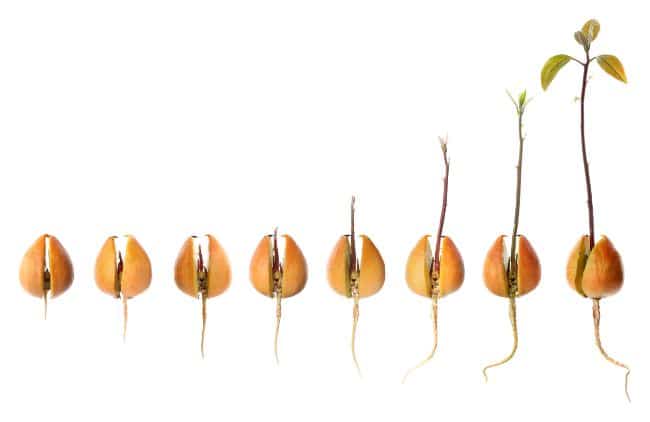
The Soil Method For Growing An Avocado Tree From Seed
This is the method recommended by David, from “The Survival Gardener”. You’ll need your avocado pit, a pot, and some well-draining potting soil.
- Open your avocado carefully so you don’t cause damage to the seed inside.
- Take out the seed and rinse it off.
- Choose a container that has good drainage holes in the bottom and fill it with loose, fast-draining, rich soil. A good potting soil or a mixture of sand and soil will work just fine.
- Plant your seed with the flat part down and the rounded or more pointy side up. The roots will emerge from the flatter side.
- Cover with soil.
- Water your seed and keep the soil damp but not soggy.
- Place your plant in a warm, sunny location.
- Wait for your plant to sprout. This could take a few weeks to a few months.
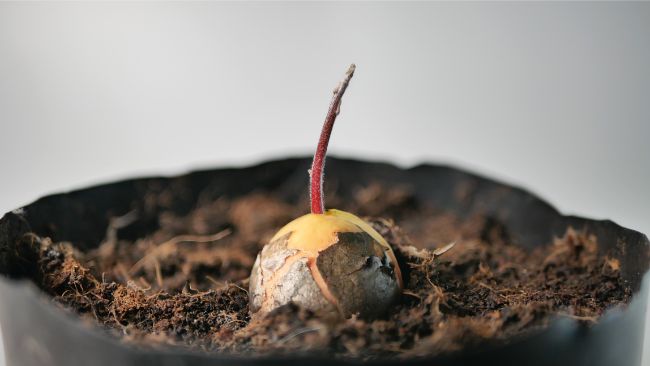
David shares more details about how to grow an avocado tree from seed in soil in this video. He explains how the seeds need to be kept moist and should be planted as soon as they are removed from the avocado. If you can’t plant them right away, place the pits in some water. Change the water every day until you are read to plant the pits into damp soil.
Should I Grow Avocados In Soil Or Water?
If you grow your avocados directly in water, you’ll be able to see the roots as they grow. This is a benefit because you’ll know which seeds are good and which seeds aren’t growing at all. You’ll also know when it is time to plant your sprouts, because you’ll be able to see when the roots are about three inches long.
However, these methods are not as natural as planting your seed right into a soil mix. The toothpick method can cause damage to the seed, making it less likely to sprout and to rot.
Todd Weinmann, Extension Horticulturist & Master Gardener Coordinator, states that seeds that are started directly in soil will produce healthier, sturdier plants.
Ultimately, both types of seed starting will work and which one you choose is a personal preference. For best results, try both and see which one works fastest and most reliably for you.
How Do You Choose The Best Avocado Seed To Grow?
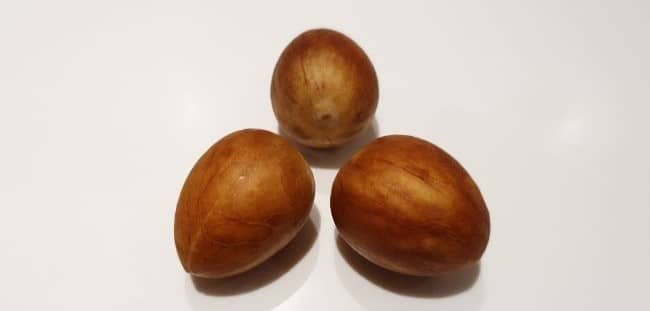
Most home-grown avocado trees are grown from the leftover pits or seeds after the avocado has been eaten, so you may not have a choice of seeds. Don’t worry if you’ve kept your avocados in the refrigerator, you seed will still grow as long as it didn’t freeze.
Like any seed, one that is moldy, crushed, or rotten is not going to grow. Other than that, it might be difficult to tell which seeds to plant and which seeds simply won’t grow. Your best option, then, if you have a choice of seeds, is to grow a selection, since not every seed will grow.
David, from thesurvivalgardener.com, shares that larger pits seems easier to grow than smaller ones. He also shares that Hass avocado pits are harder to germinate than other kinds.
If you suspend your seed in water with toothpicks, you’ll be able to see if the pit goes bad. Your water will become dark and dingy, indicating the seed has rotted and needs to be thrown away. If that happens, just try again.
If you use the soaking method, you’ll be able to see which seeds begin to crack open, making room for the roots and shoots to grow out of the seed. Seeds that float probably won’t grow and you should just throw those away. The ones that begin to rot will be obvious and you can throw those away, as well.
If you plant your seed in soil, your best bet to see if it grows will be to just wait until you have shoots poking up through the soil. Then you know your seed has sprouted and is beginning to grow.
How Do You Prepare Your Avocado Seed For The Best Results?
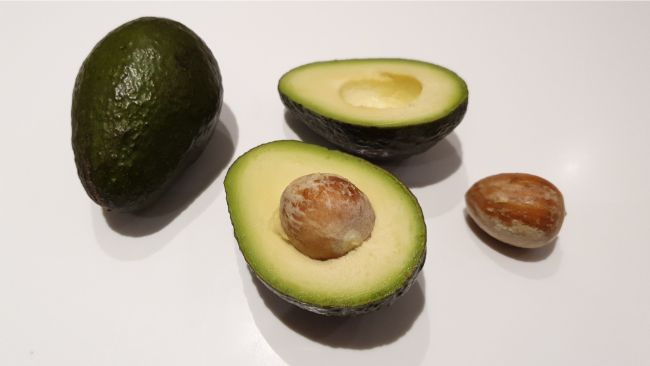
To get your avocado seed ready to plant, you’ll need to carefully remove it from your ripe avocado first. Very carefully, cut the outer shell of the avocado with a sharp knife. Don’t cut too deep or you’ll damage the seed inside. Use a spoon and gently scoop the seed out. Then wash off the flesh with warm water.
Some people also suggest removing the brown outer shell of the avocado pit to expose the inner shell. This outer shell protects the seed from damage and disease, and the theory of removing it is that in your good hands, it will not need this protection. Removing it may increase the likelihood of the seed germinating, but I have not found any hard data to support this.
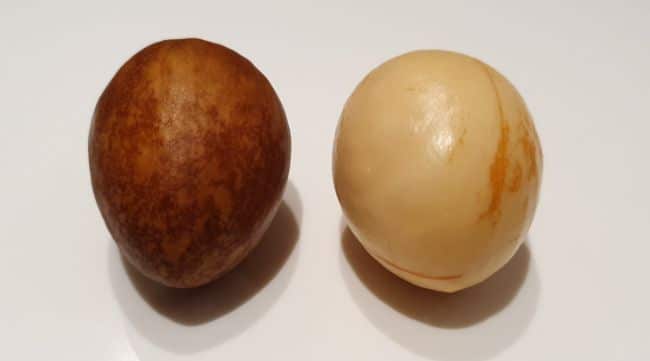
Cutting Avocado Seeds
@Avaakato of medium.com discusses the importance of washing the seed thoroughly before propagating, to remove any potential pathogens which may impact the success in growing your avocado pit.
They also suggest using a sharp knife to cut off the top 1cm and the bottom 5mms of the seed, before putting them in a container of water and placing them somewhere warm. Again, I’ve no data to suggest that this increases the success rate, but you may want to give this a try. For more detailed directions from @Avaakato, click here.
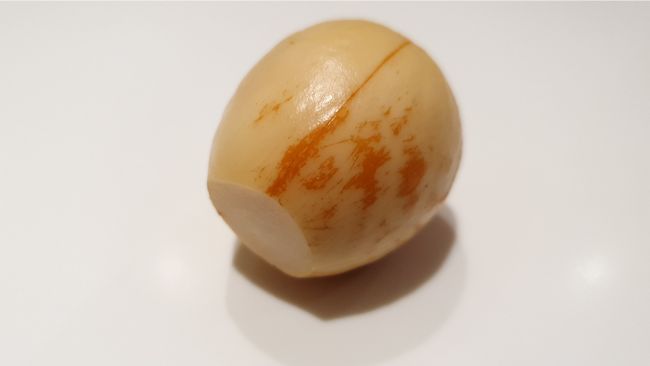
How Do You Take Care Of An Avocado Tree Grown From Seed?
Avocados grown indoors from seed can be treated like just about any typical houseplant.
Grow your avocado tree in well-draining soil. They prefer loose, aerated soil rather than heavy compact soils, which will stunt root growth. You can add sand, perlite, or bark to make the soil less compacted.
Don’t water avocado trees too frequently. It’s best to give them a long, thorough drink of water and then do not water again until the soil is slightly dry.
From time to time, flush the excess salts of the soil to prevent salt build-up in your plant, which will burn the roots and plant. Don’t fertilize your tree until after it is about a year old. You can use a typical commercial house plant fertilizer or a citrus fertilizer.
Keep them in a bright sunny window or under grow lights so they get lots of sun. Do not fertilize plants for the first year and prune them back as needed so your avocado trees do not grow too big for your space.
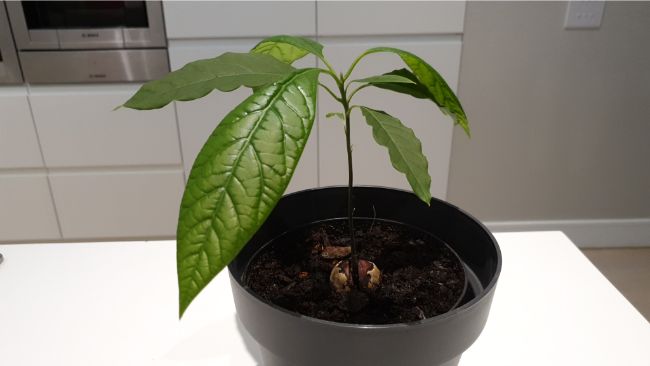
Should Avocado Trees Be Grown Indoors All Year Round?
You can grow your avocado tree indoors year-round, however, it will benefit from spending some time growing outdoors even if it is in a container. Avocado trees need lots of sunlight once they are established.
In order to fruit, your tree will need warmer days and cooler (but not cold) nights. This signals the plants hormones to begin producing fruit. Most homes do not have enough of a temperature difference between daytime and night time to produce the flowers.
If you do not live in a grow zone that supports growing avocados outdoors year-round, you may want to move your potted avocado outside when the weather is warm.
You will need to go through a hardening off process each year if you plan to move your plant from indoors to outdoors just for the summer. You will also need to acclimate the plant to being moved back inside when the fall weather begins to cool.
How Fast Do Avocados Grow?
Growing fruit trees takes time, and avocados are no exception. You can expect your avocado pit to germinate in two to six weeks, depending on growing conditions and the viability of the pit. Your avocado tree could grow as much as two feet per year.
How Big Do Avocado Trees Grow?
The size of an avocado tree depends on what type of tree it is and the conditions the tree is grown under. Dwarf avocados grow to around ten feet tall, while typical varieties grow thirty to forty feet tall. Under the right conditions, an avocado tree could grow as much as eighty feet tall.
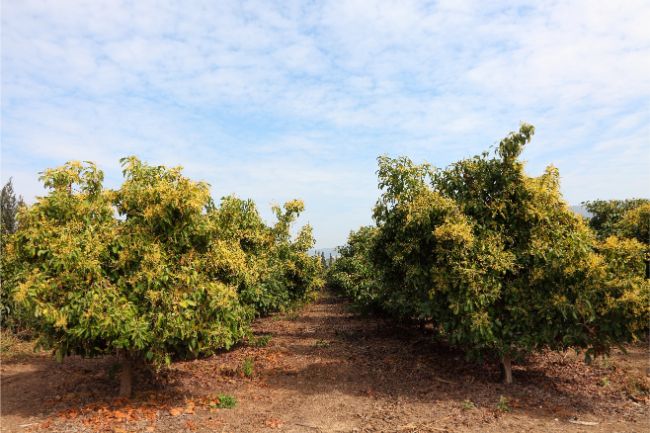
How Do You Keep An Avocado Tree Suitably Sized To Grow Indoors?
Avocado trees can grow quite large – up to eighty feet tall. In order to grow an avocado tree indoors, you’ll need to keep it well-pruned. To prune an avocado tree for the first time, you can pinch it back when it grows to about a foot tall.
After the tree has reached one foot, pinch back the stem until it is around six inches tall. This will help encourage bushier growth. You can keep pinching back your avocado tree to keep it under control.
If you are just lightly pruning your avocado tree, you can prune it at any time. If you are going to significantly prune your tree, you need to prune it right before the active period of growth begins, which is late winter or even early spring. Pruning avocado trees in July will cause the tree to flower less the following spring.
When Will You Get Avocados?
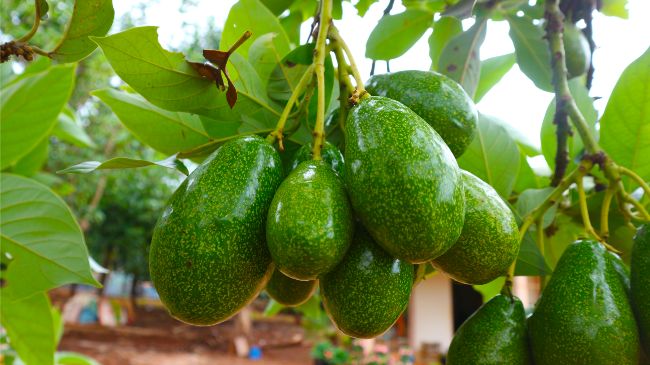
Your avocado tree can begin to bear fruit anywhere from three to fifteen years, but around five years is probably average. Surprisingly, avocados don’t ripen or soften while still on the tree. Avocados are harvested when the fruit is mature. They will ripen within one to two weeks after being picked.
If you are harvesting your own avocados, just choose some of the larger fruits and set them on your counter for a few days until they start to feel soft. You can put them in the refrigerator once they ripen to slow down the process and to prevent your avocado from over-ripening.
Avocado Blooms Are Really Interesting
Avocado blooms are unique and behave in ways other fruit trees do not. They are both male and female, but they only function as one gender at a time. One day they will open as female, and then they will close and reopen the next day as male.
This lessens the chance that the tree will self-pollinate. They come in two types: A types are female the first morning and male the second afternoon, while B types are female in the afternoon and male the following morning. This further enhances the opportunity for cross-pollination.
When the temperatures are right around 70°F (21°C), these flowers function very precisely. When the temperatures fall, more male and female flowers will be open together for longer periods, although the flowers are less viable. Avocados grown outdoors will have a larger harvest if multiple cultivars are planted near each other.
There is always a time of day when the closing of the female flowers and the opening of the male flowers overlap. The female flowers have a single stigma that stands up while the male flowers have a number of anthers that stand up.
At this point, you can use a cotton swab or a paintbrush to move pollen from the male flower to the female flower. Or you could even cut off a male flower and touch it directly to the female flower.
If your avocado tree is indoors, you will need to hand pollinate flowers in order to get the tree to bear fruit. However, if you live in a climate with warm summers, you can acclimate your potted avocado tree to the outdoors and keep it outside to be pollinated naturally.
Tips For Success Growing Avocados From Seed
- Avocado roots and shoots are very fragile, so handle them very gently.
- Sprout multiple avocado seeds at a time in case some are not viable.
- Try different methods until you find the one that works best for you.
- Keep the humidity high by grouping plants closely together, putting a dish of gravel and water under the plant, or occasionally misting the avocado tree can increase humidity. If this does not work, try a humidifier.
- Avocado trees prefer a pH of 6.0 to 6.5.
- Water your avocado tree less often in the wintertime when growth is slower.
- If you plant to keep your avocado as a houseplant, keep it well-pruned in order to manage its size.
What Are Common Problems and Solutions When Growing An Avocado Tree From Seed?
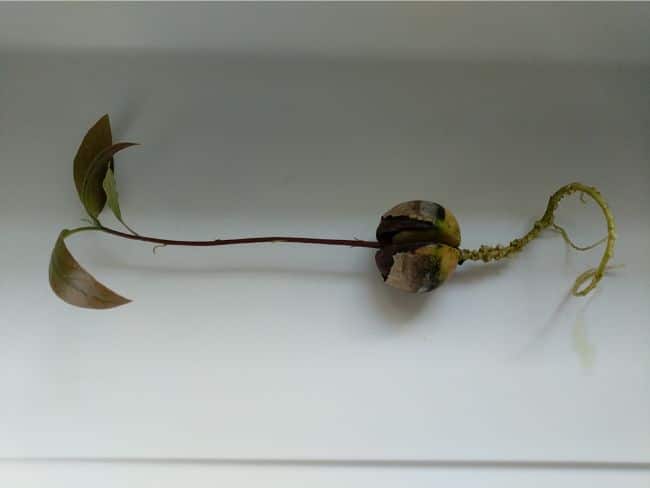
Too Much Water
The leading cause of death in avocado trees is overwatering. Avocado trees simply do not grow well in soggy soil. They have a shallow root system, and the roots will rot if they are overwatered. Symptoms of overwatering are yellowing leaves, small yellow leaves, and even dying branches.
Make sure your avocado tree has well-draining soil. Water it thoroughly, allowing the excess water to drain away. Then do not water the tree again until the soil begins to dry out. Using the wrong type of soil can lead to too much water sitting around the roots, which will damage the roots the cause root rot.
Not Enough Water
The other side of the coin is underwatering, which can significantly stunt the growth of your avocado tree. Avocado trees do have quite high water requirements, and the trick is to ensure your avocado is regularly watered without being left to sit in waterlogged soil.
Too Much Direct Sunlight
While mature avocados do well in direct sun, and need lots of sunshine to grow fruit, young plants can be scorched from the sun. Keep your eye on late afternoon sun to make sure it is not too strong for your plant.
Excess Salt Build-Up
If the tips of your avocado leaves are turning brown, you may have salt build-up in your potting soil. Salt build-up can happen from normal watering.
Another indicator of salt build-up is a white crust on top of the soil. The best way to manage salt build-up is to thoroughly flush your plants’ soil with water and allow the water to drain away.
Temperature Problems
Avocados prefer mild temperatures, between 60-85°F (16-29°C). Once established, they can tolerate lower temperatures down to around 50°F (10°C). Certain varieties, such as Guatemalan avocados, can tolerate temperatures as low as 26°F (-3°C) while Mexican avocados can handle temperatures in the low twenties.
Over-Fertilization
Too much fertilizer can lead to avocados becoming tall and spindly. This may weaken the plant as it forces it to grow too much, too fast. Some sources indicate that avocados should not be fertilized for the first year. After that, they will benefit from nitrogen and any missing minerals in the soil, such as zinc.
Becoming Rootbound
A rootbound avocado tree will have wilting leaves, no matter how much it is watered. Eventually, its growth will become stunted. A tree can die from being too rootbound. The best time to repot your avocado tree is in the spring, when it starts actively growing after the winter.
Pests
A number of pests can affect avocado trees, although this is unlikely if you are growing them indoors from seed. Some of these pests are: borers, caterpillars, thrips, lace bugs, and mites.
Mites are the most likely pest to appear indoors. Spider mites are evident by the tiny white webs scatter across the leaves of the plant. They can be washed off with a damp sponge or treated with a commercial product designed to kill spider mites.
Diseases
The most common disease in avocado trees is root rot from overwatering. They can also suffer from fruit rot, cankers, sunblotch, and blight. Cankers are wounds in the plant that ooze and can kill a tree. Fruit rot is caused by a fungus and stressed trees are more susceptible to this problem.
Little Known Facts About Avocados
- Avocados are actually a berry.
- The pit inside the avocado berry is actually a seed.
- Avocados are a healthy fat that contain vitamins B, K, C, and E.
- Avocados are 73% water
- They were first planted in the US in Florida in 1833.
- Most of the avocados eaten in the U.S. are grown in California.
- A single avocado tree can produce a million flowers and up to 200 to 300 berries in a single year.
- The Hass avocado is the most commercially popular avocado for its fruit size, taste, texture, and growability.
- The Hass avocado was first grown by Rudolph Hass, who was both a mail carrier and amateur horticulturist in California.

